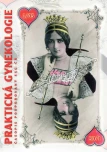Healing of peritoneum, formation of adhesions and the possibilities of their prevention
Authors:
Vít Weinberger
; I. Crha
Authors‘ workplace:
Gynekologicko-porodnická klinika LF MU a FN Brno
Published in:
Prakt Gyn 2005; 9(1): 9-12
Overview
Peritoneal healing differs from that of skin. When a defect is made in the parietal peritoneum, the entire surface becomes epithelialized simultaneously and not gradually from the borders as in epidermalization of skin wounds. While multiplication and migration of mesothelial cells from the margin of the wound may play a small part in the regenerative process, it cannot play a major role, since new mesothelium develops in the centre of a large wound at the same time as it develops in the centre of as smaller one. Development of intraperitoneal adhesions is a dynamic process whereby surgically traumatized tissues in apposition bind through fibrin bridges, which become organized by wound repair cells, often supporting a rich vascular supply as well as neuronal elements. Surgical technique, anti-adhesion liquids and barriers are used to prevent post-operative adhesions.
Key words:
peritoneal adhesions, peritoneal healing, prevention of adhesions
Sources
1. Crha I, Ventruba P, Petrenko M,Višňová H. Současné možnosti prevence adhezí a jejich imunologické aspekty. Čes Gynek 1999; 64(4): 230-234.
2. Diamond MP, Freeman ML. Clinical implications of adhesions. Hum Reprod Update 2001; 7: 567-576.
3. di Zerega GS, Campeau D. Peritoneal repair and post-surgical adhesion formation. Hum Reprod Update 2001; 7: 547-555.
4. di Zerega GS. Contemporary adhesion prevention. Fertil Steril 1994; 61: 219-235.
5. Duffy DM, diZerega GS. Adhesion controversies: pelvic pain as a cause of adhesions, crystalloids in preventing them. J Reprod Med 2001; 41: 19-26.
6. Dunn RC, Mohler M. Tissue plasminogen activator. Infer Repr Med Clin 1994; 5: 529-538.
7. Cheong YC, Laird SM, Li TC, Shelton JB et al. Peritoneal healing and adhesion formation/reformation. Hum Reprod Update 2001; 7: 556-566.
8. Johns A. Evidence-based prevention of post-operative adhesions. Hum Reprod Update 2001; 7: 577-579.
9. Kresch AJ, Seifer DB, Sachs LB et al. Laparoscopy in 100 women with chronic pelvic pain. Obstet Gynecol 1984; 64: 672-674.
10. Kužel D. Minimálně invazivní chirurgie v operační léčbě endometriózy. Moderní gynekologie a porodnictví 2002; 11(3): 385-390.
11. Nordic Adhesion Prevention Study Group: The effeciacy of Interceed (TC7) for prevention of reformation of postoperative adhesions on ovaries, Fallopian tubes, and fimbrie in microscopic operations for fertility: a multicenter study. Fertil Steril 1995; 63: 709-714.
12. Tulandi T. Introduction-prevention of adhesion formation: the journey continues. Hum Reprod Update 2001; 7: 545-546.
13. Ventruba P. Současný přístup k mikrochirurgické léčbě v gynekologii. Kandidátská disertační práce. Brno: LF UJEP 1989: 183.
Labels
Paediatric gynaecology Gynaecology and obstetrics Reproduction medicineArticle was published in
Practical Gynecology

2005 Issue 1
Most read in this issue
- Diagnostics and treatment of dysfunctional uterine bleeding
- Vaginal application of estradiol in women with urogenital atrophy – important influence on the quality of life
- Vaginal precanceroses
- Healing of peritoneum, formation of adhesions and the possibilities of their prevention
